 Faith, Race, and the Lost Cause: Confessions of a Southern Church by Christopher Alan Graham
Faith, Race, and the Lost Cause: Confessions of a Southern Church by Christopher Alan Graham
A new history of Richmond’s famous St. Paul’s Episcopal Church, attended by Robert E. Lee and Jefferson Davis during the Civil War and a tourist magnet thereafter. Christopher Alan Graham’s narrative-which emerged out of St. Paul’s History and Reconciliation Initiative-charts the congregation’s theological and secular views of race from the church’s founding in 1845 to the present day, exploring the church’s complicity in Lost Cause narratives and racial oppression in Richmond.
Graham investigates the ways that the actions of elite white southerners who imagined themselves as benevolent-liberal, even-in their treatment of Black people through the decades obscured the actual damage to Black bodies and souls that this ostensible liberalism caused. Through charting the legacy of St. Paul’s self-described benevolent paternalism on the racial and religious geography of Richmond, Graham reflects on what an authentic process of recognition and reparations might be, drawing useful lessons for America writ large.
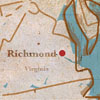 The Equal Justice Initiative website has a good brief summary of Richmond’s involvement in the Slave Trade.
The Equal Justice Initiative website has a good brief summary of Richmond’s involvement in the Slave Trade.
Click on “Richmond” below for Richmond. Click on “Equal Justice Iniative” reports for a catalog of all their slave trade reports.
Richmond, Virginia
 The Richmond Slave Trade: The Economic backbone of the Old Dominion by Jack Trammell
The Richmond Slave Trade: The Economic backbone of the Old Dominion by Jack Trammell
In many ways, the story of bondage in Virginia is the story of the state itself…
Richmond’s 15th Street was known as Wall Street in antebellum times, and like its New York counterpart, it was a center of commerce. But the business done here was unspeakable and the scene heart wrenching. With over sixty-nine slave dealers and auction houses, the Wall Street area saw tens of millions of dollars and countless human lives change hands, fueling the southern economy. Local historian and author Jack Trammell traces the history of the city’s slave trade, from the origins of African slavery in Virginia to its destruction at the end of the Civil War. Stories of seedy slave speculators and corrupt traders are placed alongside detailed accounts of the economic, political and cultural impact of a system representing the most immense, concentrated human suffering in our nation’s history.
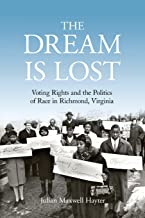 The Dream Is Lost: Voting Rights and the Politics of Race in Richmond, Virginia by Julian Maxwell Hayter
The Dream Is Lost: Voting Rights and the Politics of Race in Richmond, Virginia by Julian Maxwell Hayter
In The Dream Is Lost, Julian Maxwell Hayterdescribes more than three decades of national and local racial politics in Richmond and illuminates the unintended consequences of civil rights legislation. He uses the city’s experience to explain the political abuses that often accompany American electoral reforms and explores the arc of mid-twentieth-century urban history. In so doing, Hayter not only reexamines the civil rights movement’s origins, but also seeks to explain the political, economic, and social implications of the freedom struggle following the major legislation of the 1960s.
Hayter concludes his study in the 1980s and follows black voter mobilization to its rational conclusion―black empowerment and governance. However, he also outlines how Richmond’s black majority council struggled to the meet the challenges of economic forces beyond the realm of politics. The Dream Is Lost vividly illustrates the limits of political power, offering an important view of an underexplored aspect of the post–civil rights era.
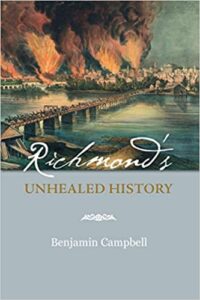 Richmond’s Unhealed History by Reverend Benjamin Campbell
Richmond’s Unhealed History by Reverend Benjamin Campbell
In a detailed look at the history of Richmond, Benjamin Campbell examines the contradictions and crises that have formed the city over more than four centuries. Campbell argues that the community of metropolitan Richmond is engaged in a decisive spiritual battle in the coming decade. He believes the city, more than any in the nation, has the potential for an unprecedented and historic achievement. Its citizens can redeem and fulfill the ideals of their ancestors, proving to the world that race and class can be conquered by the deliberate and prayerful intention of honest and dedicated citizens.
 The Devil’s Half Acre: The Untold Story of How One Woman Liberated the South’s Most Notorious Slave Jail by Kristen Green
The Devil’s Half Acre: The Untold Story of How One Woman Liberated the South’s Most Notorious Slave Jail by Kristen Green
The inspiring true story of an enslaved woman who liberated an infamous slave jail and transformed it into one of the nation’s first HBCUIn The Devil’s Half Acre, New York Times bestselling author Kristen Green draws on years of research to tell the extraordinary and little-known story of young Mary Lumpkin, an enslaved woman who blazed a path of liberation for thousands. She was forced to have the children of a brutal slave trader and live on the premises of his slave jail, known as the “Devil’s Half Acre.” When she inherited the jail after the death of her slaveholder, she transformed it into “God’s Half Acre,” a school where Black men could fulfill their dreams. It still exists today as Virginia Union University, one of America’s first Historically Black Colleges and Universities.
A sweeping narrative of a life in the margins of the American slave trade, The Devil’s Half Acre brings Mary Lumpkin into the light. This is the story of the resilience of a woman on the path to freedom, her historic contributions, and her enduring legacy.
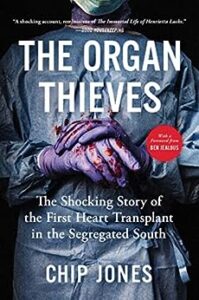 The Organ Thieves: The Shocking Story of the First Heart Transplant in the Segregated South by Chip Jones
The Organ Thieves: The Shocking Story of the First Heart Transplant in the Segregated South by Chip Jones
In 1968, Bruce Tucker, a black man, went into Virginia’s top research hospital with a head injury, only to have his heart taken out of his body and put into the chest of a white businessman. Now, in The Organ Thieves, Pulitzer Prize–nominated journalist Chip Jones exposes the horrifying inequality surrounding Tucker’s death and how he was used as a human guinea pig without his family’s permission or knowledge. The circumstances surrounding his death reflect the long legacy of mistreating African Americans that began more than a century before with cadaver harvesting and worse.
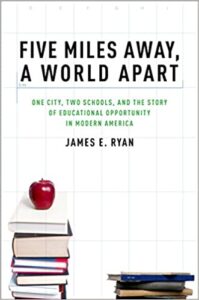 Five Miles Away, A World Apart: One City, Two Schools, and the Story of Educational Opportunity in Modern America by James E. Ryan
Five Miles Away, A World Apart: One City, Two Schools, and the Story of Educational Opportunity in Modern America by James E. Ryan
In his important new book, Five Miles Away, A World Apart, James E. Ryan answers this question by tracing the fortunes of two schools in Richmond, Virginia–one in the city and the other in the suburbs. Ryan shows how court rulings in the 1970s, limiting the scope of desegregation, laid the groundwork for the sharp disparities between urban and suburban public schools that persist to this day. The Supreme Court, in accord with the wishes of the Nixon administration, allowed the suburbs to lock nonresidents out of their school systems. City schools, whose student bodies were becoming increasingly poor and black, simply received more funding, a measure that has proven largely ineffective, while the independence (and superiority) of suburban schools remained sacrosanct. Weaving together court opinions, social science research, and compelling interviews with students, teachers, and principals, Ryan explains why all the major education reforms since the 1970s–including school finance litigation, school choice, and the No Child Left Behind Act–have failed to bridge the gap between urban and suburban schools and have unintentionally entrenched segregation by race and class. As long as that segregation continues, Ryan forcefully argues, so too will educational inequality. Ryan closes by suggesting innovative ways to promote school integration, which would take advantage of unprecedented demographic shifts and an embrace of diversity among young adults.
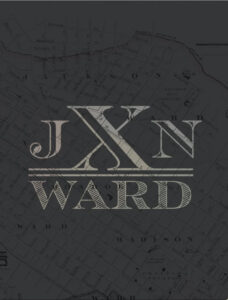 The Jackson Project The JXN Project endeavors to celebrate the 150th anniversary of Jackson Ward by properly contextualizing the origin story of the nation’s first historically registered Black urban neighborhood. The project is designed to excavate, elevate, and educate on the hidden histories of Jackson Ward as the “Birthplace of Black Entrepreneurship”, an often under-told and overlooked story when discussing the local origins of Black excellence and enterprise in the national narrative. Website https://thejxnproject.com/
The Jackson Project The JXN Project endeavors to celebrate the 150th anniversary of Jackson Ward by properly contextualizing the origin story of the nation’s first historically registered Black urban neighborhood. The project is designed to excavate, elevate, and educate on the hidden histories of Jackson Ward as the “Birthplace of Black Entrepreneurship”, an often under-told and overlooked story when discussing the local origins of Black excellence and enterprise in the national narrative. Website https://thejxnproject.com/
A video trailer is available https://youtu.be/GpPe7V3j57k
Other videos are available here.
